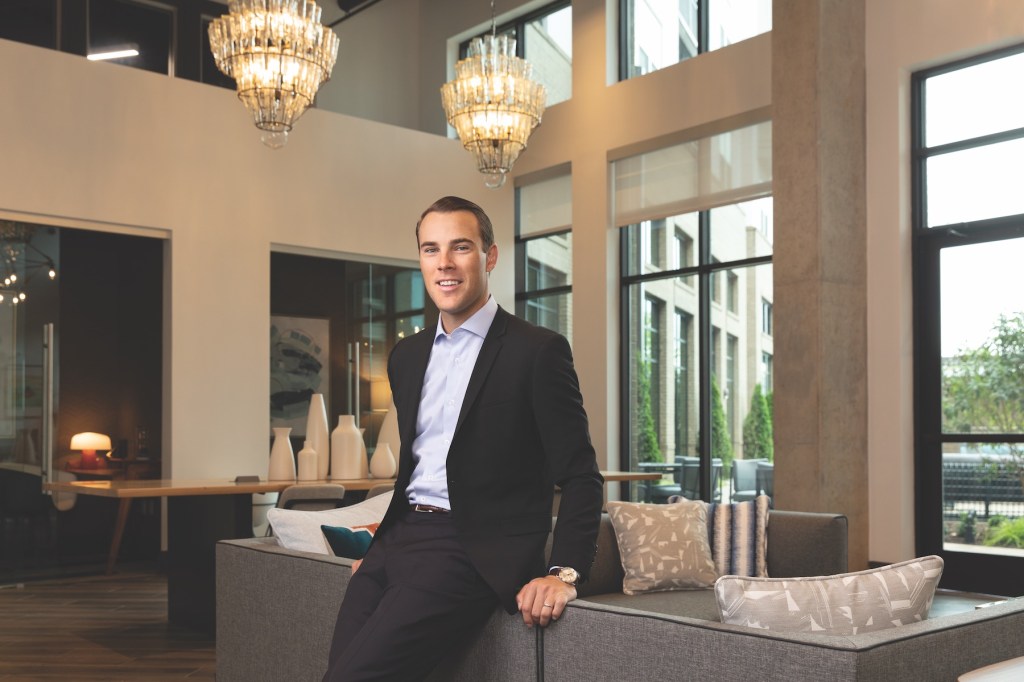John Gray graduated with a degree in economics and an interest in real estate investment. He quickly found a job in his desired profession working for Grandbridge Real Estate Capital. This all happened in summer 2007—not the best time to go into a real estate career.
When the housing bubble burst at the end of 2008, Gray’s focus switched to multifamily. He didn’t have much of a choice. “Everything fell apart,” he says, “so all the debt that was left was Freddie Mac and Fannie Mae in the multifamily sector.”
JOHN GRAY AT A GLANCE
Company : LMC Investments
Title: President
Age: 35
Favorite hobbies: I love to travel. I’m on the road about 200 days a year for work, as is my wife. I love getting to places people don’t often see because I think it makes you smarter and a more versatile person. My first four years out of school we worked all the time, so I took two weeks off before starting with Crescent and went to Australia. After that trip, I set a goal to see six continents by the time I turned 30. (I made it by 31!) These adventures made me much more confident. I can sit down in a conference room anywhere in the world and relate to people I don’t know because of my varied experiences.
Best professional advice: Hitch your wagon to a superstar. Finding an amazing leader to learn business—and all parts of life—from is critical. Being self-taught will take you somewhere 20 times longer than having a great coach.
Leadership philosophy: What I’ve absorbed from Todd [Farrell] is always do the right thing and don’t take short cuts to reach your goals. Also, empower people to make decisions, so everyone feels like they’re running their own business.
Biggest professional risk: The first was leaving a big bank to work for Todd at Crescent, which had just come out of bankruptcy during the recession. I saw an amazing leader in Todd and great assets on its balance sheet. Then I left Crescent, which had grown in the few years I was there, and went to Lennar. Finding my way into a growing company
as a young person and getting a seat that was also set to grow was a risk with potential for great reward.
Where do you see yourself in five years? Our intent at Lennar is to build an evergreen business. We do that with an amazing team. We have capital partners in place and incredible communities and associates, so we work toward continued growth.
This challenging start to his career possibly explains Gray’s ability to successfully assess and take risks. One such risk was being one of the first hires in 2011 to launch the multifamily development arm for Lennar, the second-largest single-family U.S. home builder by closings. At the time, Gray was working at Crescent Resources with his mentor, Todd Farrell. Lennar reached out to Farrell first for advice on its new venture, and then with a job offer. A job offer for Gray followed within a week.
Although his initial move into multifamily relates to the timing of the housing market downturn, Gray knew he wanted to continue in this direction when Lennar’s offer came his way.
“My dad was in the industry for a long time—mostly property management, then development,” he explains. “I like multifamily. It’s a tangible development, and everyone needs a place to live. It allows you to improve the quality of people’s lives through what you create.”
Starting Up
Lennar Multifamily Communities—or LMC as it’s known—launched in 2011 with a staff of two. Gray began as an associate working closely with Farrell, overseeing many aspects of operating and growing the business. From analyzing potential markets, writing pitches, sourcing land, and raising capital to designing processes, Gray learned all parts of developing multifamily projects.
The road map Gray says he and Farrell followed in order to quickly grow the fledgling company involved focusing on “pipeline, people, and processes.”
The pipeline equals identifying profitable markets and acquiring the best sites for new multifamily communities. Farrell worked on the people part of the mantra by hiring developers in markets they identified. “Once he built the amazing team, I really dug in and got into corporate processes, investment procedures, and all the tenets of running a big company,” says Gray. “We were building our strategy for growth at a significant scale.”
Growth came quickly thanks to the support of its parent company. Gray highlights Lennar’s sheer scale by noting that in the past 15 years, the company has averaged over $400 million in land purchases each quarter.
During this time of establishing how a single-family builder would become a formidable player in the multifamily arena, Gray knew streamlining processes was crucial. Making sure reporting and evaluating relative investment decisions from across the company aligned as a single system would set a strong base for future growth. According to his nomination, Gray was instrumental in creating this system: “Nearly all of the forms by which we use to make decisions internally on deals or potential deals were authored by John—he has taken a company whose executives were from many different national developers and streamlined the process of reporting.”

Courtesy LMC Properties
NordHaus, a luxury mixed-use apartment community in northeastern Minneapolis.

Courtesy LMC Properties
Best In Class
Deciding to focus on Class A properties made the most sense for LMC. After all, Lennar’s biggest advantage remains its land control, so building new, high-end communities was practically a given. In addition, Lennar also builds most properties itself. This meant the potential returns for building new easily topped those for buying.
“Our push toward Class A was more about what makes economic sense when building new,” Gray explains. “The vast majority of cost is mandated by building code, so by the time you design a new building the decision to use high-end finishes generates an incremental cost increase versus what the residents pay for nicer finishes. We also recognize the huge need for affordable housing in the U.S. and are actively pursuing a prototype to make development in that area viable.”
Once LMC decided to build Class A, determining the best markets came next. Analyzing the fiscal advantages of certain markets over others is another one of Gray’s fortes. According to the economics major, the “multifamily industry is simple in that you have to follow job growth when you rely on 300 sources of credit for paying rent. You also need markets large enough where you’ll have exit liquidity if you ever want to sell. Same goes for needing to look at areas with availability of equity capital.”
Those factors narrowed LMC’s market research to the country’s 25 most populated metropolitan areas. Gray says their developers’ efforts in identifying submarkets within those areas really sets the company apart. They look at dynamics such as employment opportunities and population growth as well as where renters spend their money—mainly restaurants and entertainment venues.
In order for LMC’s developers to locate appealing submarkets, they needed to live in those same areas. From their staff of two in 2011, the company now maintains 12 regional offices in urban locations across the country, in addition to its Charlotte, N.C.–based headquarters.
“We try to keep the business feeling local,” Gray says. “Our regional offices know their markets and get a lot of autonomy in making decisions.”
Gray adds that the company is researching two new markets in Midwestern cities. LMC began to focus more on acquisition recently as the gap between return on investment for new construction and buying existing buildings closes.
He also worked on shifting LMC’s business model several years ago. Instead of merchant building, the company moved to build and hold. This means LMC gets to “hang onto all of these great assets and oversee the operations of the communities ourselves instead of selling off the upside to someone else.”
Money Matters
As LMC grew, Gray tapped into his investment background and worked more specifically on project development. He eventually became LMC’s head of investments, evaluating investments and working with investors to raise capital. This move completed his circular career path in a span of 12 years from graduation to investment to development and back to investment.
A little more than a year ago—in true calculated risk–taking style—he elevated this role further by leading in the formation of LMC Investments. As the 30-something president of this burgeoning multifamily investment fund, Gray helped raise $3.5 billion in equity to create Lennar Multifamily Venture I and Lennar Multifamily Venture II.
“We wanted to provide a direct investment option for big investors,” Gray says. “I meet with some of the world’s largest investors to explain who we are, why we think our fund vehicles make good investments, and what investment objectives we can meet. It’s amazing to spend time with these folks and see how the world invests.”
Gray and his team recently closed Lennar Multifamily Venture II. These build-and-hold vehicles support about 80% of LMC’s business capital, while the remaining 20% comes from single-asset providers, such as Prudential, Resmark, Goldman Sachs, and Carlyle.
Gray reflects on his big risk taken eight years ago and how far he and LMC have come in that time. He faced big questions when he joined the startup, most notably, would Lennar fully commit to multifamily?
“It was a calculated risk. They were—and are—perennially successful in single-family, so I believed they would commit to the multifamily sector—and they went above and beyond that commitment,” he says. “Lennar initially earmarked $250 million toward launching this part of the business. Today we have more than $6 billion in operating or under construction multifamily assets from nothing in 2011. We control more than 30,000 apartment homes—including future projects—or $12 billion in properties.”
